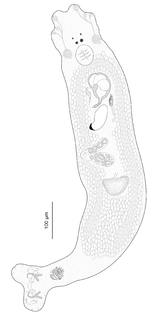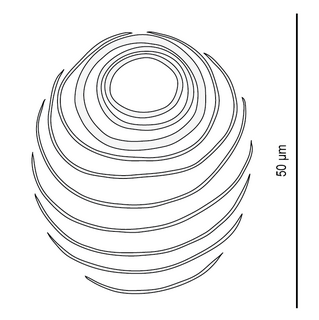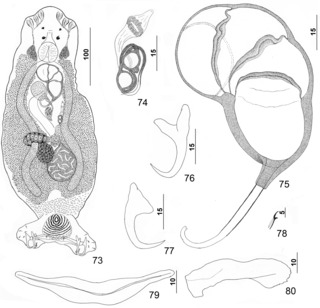
Pseudorhabdosynochus is a genus of monopisthocotylean monogeneans, included in the family Diplectanidae. The type-species of the genus is Pseudorhabdosynochus epinepheli .

The Diplectanidae are a family of monopisthocotylean monogeneans. They are all parasitic on the gills of fish. Diplectanids are small animals, generally around 1 mm in length. As parasites, they can be extremely numerous, up to several thousand on an individual fish.

Pseudorhabdosynochus epinepheli is a diplectanid monogenean parasitic on the gills of species of groupers. It is the type species of the genus Pseudorhabdosynochus Yamaguti, 1958.

Pseudorhabdosynochus regius is a diplectanid monogenean parasitic on the gills of the mottled grouper .
Calydiscoides is a genus of monopisthocotylean monogeneans, included in the family Diplectanidae.

Lamellodiscs are epidermal structures, which are typical of and found only in certain monogeneans of the family Diplectanidae. There are, typically, two lamellodiscs, one ventral and one dorsal, located on the haptor of the monogenean. Lamellodiscs are made up of concentric lamellae embedded in the epidermis. Lamellodiscs are considered as special type of squamodiscs, which are homologous structure found in many diplectanid monogeneans but formed of rows of rodlets instead of lamellae.

Pseudorhabdosynochus americanus is a diplectanid monogenean parasitic on the gills of groupers. It was described as Diplectanum americanum by Price in 1937 and transferred to the genus Pseudorhabdosynochus by Kritsky and Beverley-Burton in 1986. The species was redescribed by Kritsky, Bakenhaster and Adams in 2015.

Pseudorhabdosynochus mcmichaeli is a diplectanid monogenean parasitic on the gills of the scamp, Mycteroperca phenax. It has been described by Kritsky, Bakenhaster and Adams in 2015.

Pseudorhabdosynochus bunkleywilliamsae is a diplectanid monogenean parasitic on the gills of the Nassau grouper, Epinephelus striatus. It has been described by Kritsky, Bakenhaster and Adams in 2015.

Pseudorhabdosynochus beverleyburtonae is a diplectanid monogenean parasitic on the gills of the dusky grouper, Epinephelus marginatus. It has been described by Guy Oliver in 1984 as Cycloplectanum beverleyburtonae, redescribed by Oliver in 1987, transferred to the genus Pseudorhabdosynochus by Kritsky & Beverley-Burton in 1986 as Pseudorhabdosynochus beverleyburtonae, redescribed by Kritsky, Bakenhaster and Adams in 2015, and redescribed in 2016 by Chaabane, Neifar, Gey & Justine.
Pseudorhabdosynochus amplidiscatus is a diplectanid monogenean parasitic on the gills of groupers. It was described as Diplectanum amplidiscatum by Bravo-Hollis in 1954 and transferred to the genus Pseudorhabdosynochus by Kritsky and Beverley-Burton in 1986.

Pseudorhabdosynochus oliveri is a diplectanid monogenean parasitic on the gills of the dusky grouper.
Pseudorhabdosynochus bocquetae is a diplectanid monogenean parasitic on the gills of groupers. It has been described in 1984 by Guy Oliver and Ilan Paperna. The species was first described as Cycloplectanum bocquetae and transferred to the genus Pseudorhabdosynochus by Delane C. Kritsky and Mary Beverley-Burton in 1986.

Pseudorhabdosynochus jeanloui is a diplectanid monogenean parasitic on the gills of the Pacific creolefish, Paranthias colonus. It has been described in 2015 by Knoff, Cohen, Cárdenas, Cárdenas-Callirgos & Gomes.
Pseudorhabdosynochus cupatus is a species of diplectanid monogenean parasitic on the gills of groupers.
Pseudorhabdosynochus hargisi is species of a diplectanid monogenean parasitic on the gills of the White grouper Epinephelus aeneus. It was described in 1984 as Diplectanum hargisi and transferred to the genus Pseudorhabdosynochus by Santos, Buchmann & Gibson in 2000. Its systematic position has been clarified by Kritsky, Bakenhaster & Adams in 2015, who differentiated it from Pseudorhabdosynochus americanus.
Pseudorhabdosynochus melanesiensis is a diplectanid monogenean parasitic on the gills of the grouper, Epinephelus merra. It was described in 1958 as Diplectanum melanesiensis then transferred to the genus Pseudorhabdosynochus by Kritsky & Beverley-Burton in 1986.
Pseudorhabdosynochus summanae is a species of diplectanid monogenean parasitic on the gills of the grouper Epinephelus summana. It was described in 1969, from only four specimens, under the name Diplectanum summanae and transferred to the genus Pseudorhabdosynochus in 1986.
Pseudorhabdosynochus vagampullum is a species of diplectanid monogenean parasitic on the gills of a grouper. It was described in 1969, from eight specimens, under the name Diplectanum vagampullum and transferred to the genus Pseudorhabdosynochus in 1986. The species has been redescribed several times.
Nasobranchitrema is a genus of monopisthocotylean monogeneans, belonging to the family Diplectanidae. The position of Nasobranchitrema within the family Diplectanidae is a matter of controversy. Oliver considered that the absence of squamodisc and adhesive plate in the haptor and the position of the ovary made the genus closer to the Ancyrocephalidae than to the Diplectanidae.












